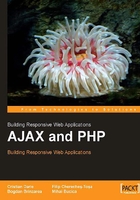
Chapter 2. Client-Side Techniques with Smarter JavaScript
It is said that one picture is worth a thousand words. And so is a well-written piece of code, we would say. You will get plenty of both, while building the foundations for your future AJAX‑enabled applications, in this chapter and the next.
Hopefully, the first chapter has developed your interest in AJAX well enough that you will endure a second chapter with lots of theory to be learned. On the other hand, if you found the first exercise too challenging, be assured that this time we will advance a bit slower. We will learn the theory in parts by going through many short examples. In this chapter, we will meet client AJAX technologies, which include:
- JavaScript
- The JavaScript DOM
- Cascading Style Sheets (CSS)
- The
XMLHttpRequestobject - Extensible Markup Language (XML)
You will learn how to make these components work together smoothly, and form a strong foundation for your future AJAX applications. You will see how to implement efficient error handling techniques, and how to write code efficiently. Chapter 3 will complete the foundations by presenting the techniques and technologies that you use on the server; in our case, PHP, MySQL, and others.
To be a good AJAX developer you need to know very well how its ingredients work separately, and then master how to make them work together. In this book, we assume you have some experience with at least a part of these technologies.
Depending on your experience level, take some time—before, while, or after reading Chapter 2 or Chapter 3, to have a look at Appendix B on http://ajaxphp.packtpub.com, which shows you a number of tools that make a programmer’s life much easier. Don’t skip it, because it’s important, as having the right tools and using them efficiently can make a very big difference.
You can see all the example applications from this book online at http://ajaxphp.packtpub.com/.